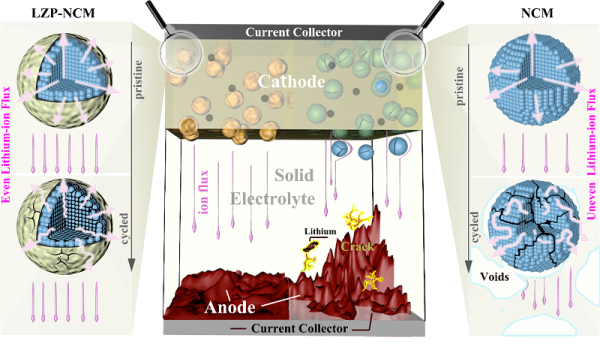01
2023
-
05
New research achievements obtained by Qingdao Energy Research Institute in assisting the development of high nickel ternary sulfide based all solid state batteries
Qingdao Energy Research Institute has made progress in the research on the failure mechanism of sulfide based all solid state batteries, revealing the decay mechanism of positive reinforcement between the positive and negative electrodes caused by the dynamic evolution of lithium ion transport dynamics in sulfide based all solid state batteries. It is the first time that the positive and negative electrodes of all solid state metal lithium batteries trust each other and are related to each other, It lays a research foundation for the development of the next generation of high energy density and high safety nickel ternary sulfide based all solid state battery.

Research Progress on failure mechanism of sulfide solid state battery in Qingdao Energy Institute
Recently, the solid-state energy system technology center led by cuiguanglei, a researcher at the Qingdao Institute of bioenergy and processes, Chinese Academy of Sciences, has made important progress in the study of failure mechanism and performance improvement of sulfide based all solid-state batteries. Relevant achievements were published in the Science Bulletin.
The sulfide based all solid state lithium metal battery, which is composed of high theoretical capacity, high nickel layered cathode material and lithium metal anode, is expected to solve the problems of low energy density and poor safety of current commercial lithium-ion batteries, and is one of the promising next-generation high specific energy battery technologies. Experimental studies show that all solid state batteries have problems such as short cycle life, low coulomb efficiency and fast capacity decline, which affect their further development and application. Due to the lack of appropriate characterization methods, the degradation mechanism of all solid state batteries is still unclear. Therefore, accurate and reliable advanced characterization methods are needed to analyze the degradation failure mechanism of electrode materials to clarify the intrinsic degradation mechanism of batteries.
Using advanced high-resolution non-destructive three-dimensional synchrotron radiation X-ray tomography (sxct), researchers studied the degradation mechanism of lini0.8co0.1mn0.1o2 (NCM) | li6ps5cl| Li solid-state battery. The experimental results show that the reaction heterogeneity induced by the electrochemical mechanical coupling failure of the positive electrode produces uneven lithium ion flux and transfers it to the negative electrode, resulting in uneven lithium deposition, dissolution behavior and the generation of dead lithium. The non-uniform electrochemical reaction behavior of lithium negative electrode reacts on the positive electrode and strengthens its reaction heterogeneity, forming a positive strengthening mechanism of positive and negative electrode recession promoting each other. As the battery continues to circulate, the uneven reaction between the positive and negative electrodes intensifies, resulting in structural damage. At the same time, the volume shrinkage of the positive and negative electrodes causes the plastic deformation of the electrolyte, which eventually leads to the failure of the battery. Comparative experiments show that the cathode modified with lizr2 (PO4) 3 (lzp) can effectively inhibit the electrochemical mechanical coupling failure of the cathode, and significantly improve the deposition dissolution uniformity of lithium and the structural integrity of the electrolyte. This work reveals the decay mechanism of positive reinforcement between positive and negative electrodes caused by the dynamic evolution of lithium ion transport dynamics in sulfide based all solid state batteries, and puts forward the failure behavior of mutual trust and correlation between positive and negative electrodes of all solid state metal lithium batteries for the first time, which provides new ideas and guidance for the further optimization and development of all solid state batteries, It lays a research foundation for the development of the next generation of high energy density and high safety nickel ternary sulfide based all solid state battery.
The research work has been supported by the National Natural Science Foundation of China, the strategic leading science and technology project of the Chinese Academy of Sciences, the youth innovation promotion association of the Chinese Academy of Sciences and the Shandong Energy Research Institute.



